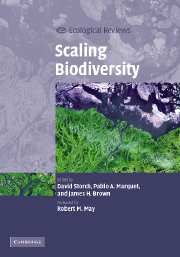Book contents
- Frontmatter
- Contents
- List of contributors
- Foreword by Robert M. May (Lord May of Oxford)
- Preface
- 1 Introduction: scaling biodiversity – what is the problem?
- PART I Spatial scaling of species richness and distribution
- 2 Species–area curves and the geometry of nature
- 3 The distribution of species: occupancy, scale, and rarity
- 4 Species distribution patterns, diversity scaling and testing for fractals in southern African birds
- 5 Geometry of species distributions: random clustering and scale invariance
- 6 Toward a mechanistic basis for a unified theory of spatial structure in ecological communities at multiple spatial scales
- PART II Alternative measures of biodiversity: taxonomy, phylogeny, and turnover
- PART III Scaling of biological diversity with energy and the latitudinal biodiversity gradient
- PART IV Processes, perspectives, and syntheses
- Index
- Plate section
- References
5 - Geometry of species distributions: random clustering and scale invariance
Published online by Cambridge University Press: 05 August 2012
- Frontmatter
- Contents
- List of contributors
- Foreword by Robert M. May (Lord May of Oxford)
- Preface
- 1 Introduction: scaling biodiversity – what is the problem?
- PART I Spatial scaling of species richness and distribution
- 2 Species–area curves and the geometry of nature
- 3 The distribution of species: occupancy, scale, and rarity
- 4 Species distribution patterns, diversity scaling and testing for fractals in southern African birds
- 5 Geometry of species distributions: random clustering and scale invariance
- 6 Toward a mechanistic basis for a unified theory of spatial structure in ecological communities at multiple spatial scales
- PART II Alternative measures of biodiversity: taxonomy, phylogeny, and turnover
- PART III Scaling of biological diversity with energy and the latitudinal biodiversity gradient
- PART IV Processes, perspectives, and syntheses
- Index
- Plate section
- References
Summary
Introduction
Spatial biodiversity patterns are tightly related to the patterns of spatial distribution of individual species. It has been recognized that the spatial distribution of individuals is never random nor homogeneous within some well-defined clusters but is aggregated on many spatial scales: individuals form clusters which themselves are aggregated into larger clusters and so on. The most useful way to capture these patterns is with fractal geometry, which treats such patterns as self-similar sets (Kunin, 1998; Halley et al., 2004). Indeed, it has been shown that species spatial distribution is often close to fractal (Virkkala, 1993; Condit et al., 2000; Ulrich & Buszko, 2003) and that the assumption of fractality of species spatial distribution is appropriate for deriving multispecies macroecological patterns, namely the species–area relationship (Harte, Kinzig & Green, 1999; Šizling & Storch, 2004). By contrast, species sometimes reveal distributions that deviate from strict fractality (Hartley et al., 2004; He & Condit, this volume; Lennon et al., this volume). More importantly, although there are several ways in which fractal distributions could emerge (Halley et al., 2004), there is no strong biological reason why species spatial distribution should be exactly fractal, i.e. it is unclear which biological processes should produce fractal distribution.
Here we show that species spatial distributions which are very close to fractal can emerge from random processes leading to aggregation on several spatial scales. These processes have relatively straightforward biological interpretation and the spatial patterns they produce are in many parameters effectively undistinguishable from classical fractals.
- Type
- Chapter
- Information
- Scaling Biodiversity , pp. 77 - 100Publisher: Cambridge University PressPrint publication year: 2007
References
- 11
- Cited by

